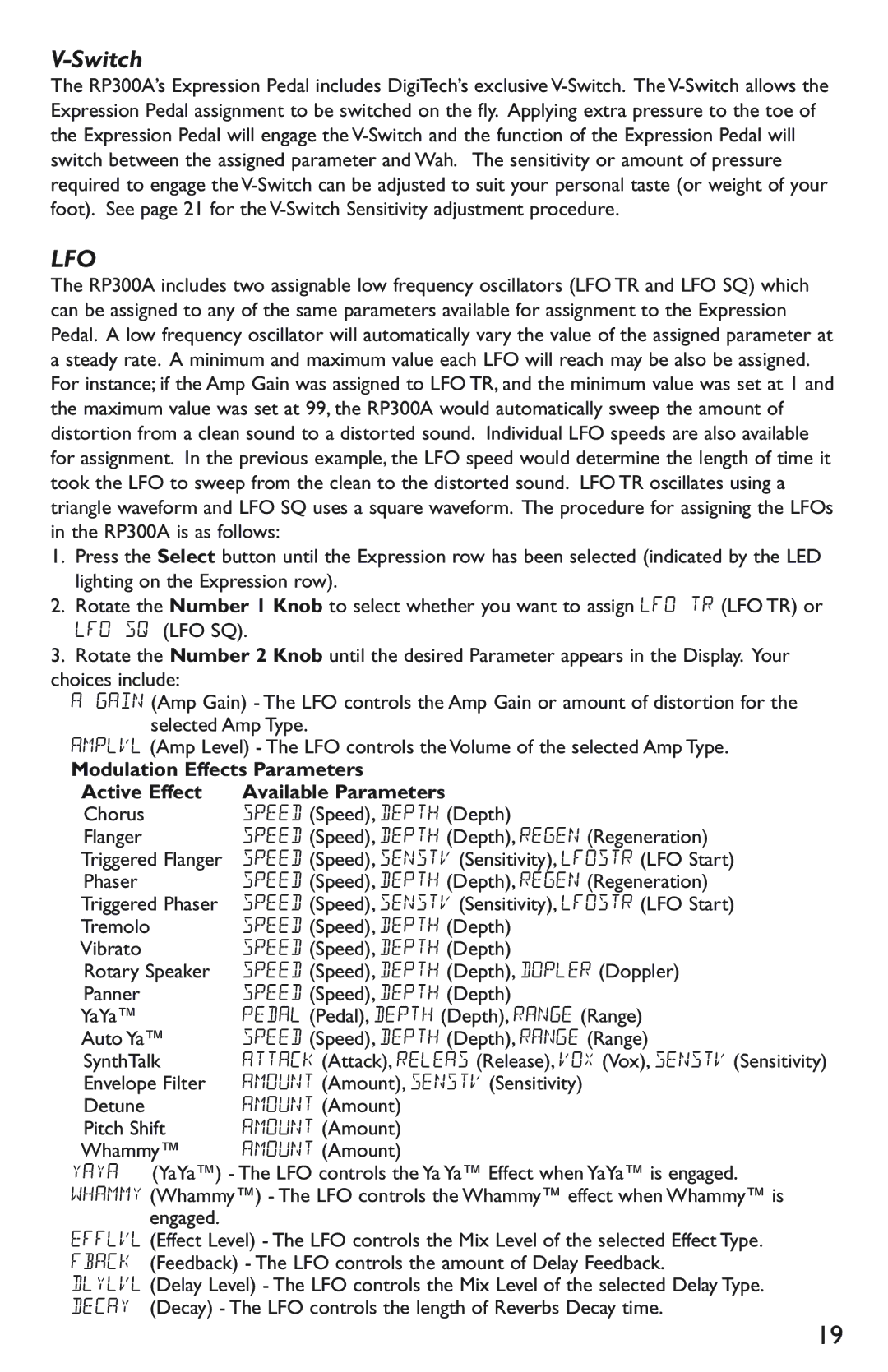V-Switch
The RP300A’s Expression Pedal includes DigiTech’s exclusive
LFO
The RP300A includes two assignable low frequency oscillators (LFO TR and LFO SQ) which can be assigned to any of the same parameters available for assignment to the Expression Pedal. A low frequency oscillator will automatically vary the value of the assigned parameter at a steady rate. A minimum and maximum value each LFO will reach may be also be assigned. For instance; if the Amp Gain was assigned to LFO TR, and the minimum value was set at 1 and the maximum value was set at 99, the RP300A would automatically sweep the amount of distortion from a clean sound to a distorted sound. Individual LFO speeds are also available for assignment. In the previous example, the LFO speed would determine the length of time it took the LFO to sweep from the clean to the distorted sound. LFO TR oscillates using a triangle waveform and LFO SQ uses a square waveform. The procedure for assigning the LFOs in the RP300A is as follows:
1. Press the Select button until the Expression row has been selected (indicated by the LED lighting on the Expression row).
2. Rotate the Number 1 Knob to select whether you want to assign LFO TR (LFO TR) or LFO SQ (LFO SQ).
3. Rotate the Number 2 Knob until the desired Parameter appears in the Display. Your choices include:
AGAIN (Amp Gain) - The LFO controls the Amp Gain or amount of distortion for the selected Amp Type.
AMPLVL (Amp Level) - The LFO controls the Volume of the selected Amp Type.
Modulation Effects Parameters
Active Effect | Available Parameters |
Chorus | SPEED (Speed), DEPTH (Depth) |
Flanger | SPEED (Speed), DEPTH (Depth), REGEN (Regeneration) |
Triggered Flanger | SPEED (Speed), SENSTV (Sensitivity), LFOSTR (LFO Start) |
Phaser | SPEED (Speed), DEPTH (Depth), REGEN (Regeneration) |
Triggered Phaser | SPEED (Speed), SENSTV (Sensitivity), LFOSTR (LFO Start) |
Tremolo | SPEED (Speed), DEPTH (Depth) |
Vibrato | SPEED (Speed), DEPTH (Depth) |
Rotary Speaker | SPEED (Speed), DEPTH (Depth), DOPLER (Doppler) |
Panner | SPEED (Speed), DEPTH (Depth) |
YaYa™ | PEDAL (Pedal), DEPTH (Depth), RANGE (Range) |
Auto Ya™ | SPEED (Speed), DEPTH (Depth), RANGE (Range) |
SynthTalk | ATTACK (Attack), RELEAS (Release), VOX (Vox), SENSTV (Sensitivity) |
Envelope Filter | AMOUNT (Amount), SENSTV (Sensitivity) |
Detune | AMOUNT (Amount) |
Pitch Shift | AMOUNT (Amount) |
Whammy™ | AMOUNT (Amount) |
YAYA (YaYa™) - The LFO controls the Ya Ya™ Effect when YaYa™ is engaged. WHAMMY (Whammy™) - The LFO controls the Whammy™ effect when Whammy™ is
engaged.
EFFLVL (Effect Level) - The LFO controls the Mix Level of the selected Effect Type. FBACK (Feedback) - The LFO controls the amount of Delay Feedback.
DLYLVL (Delay Level) - The LFO controls the Mix Level of the selected Delay Type. DECAY (Decay) - The LFO controls the length of Reverbs Decay time.
19
